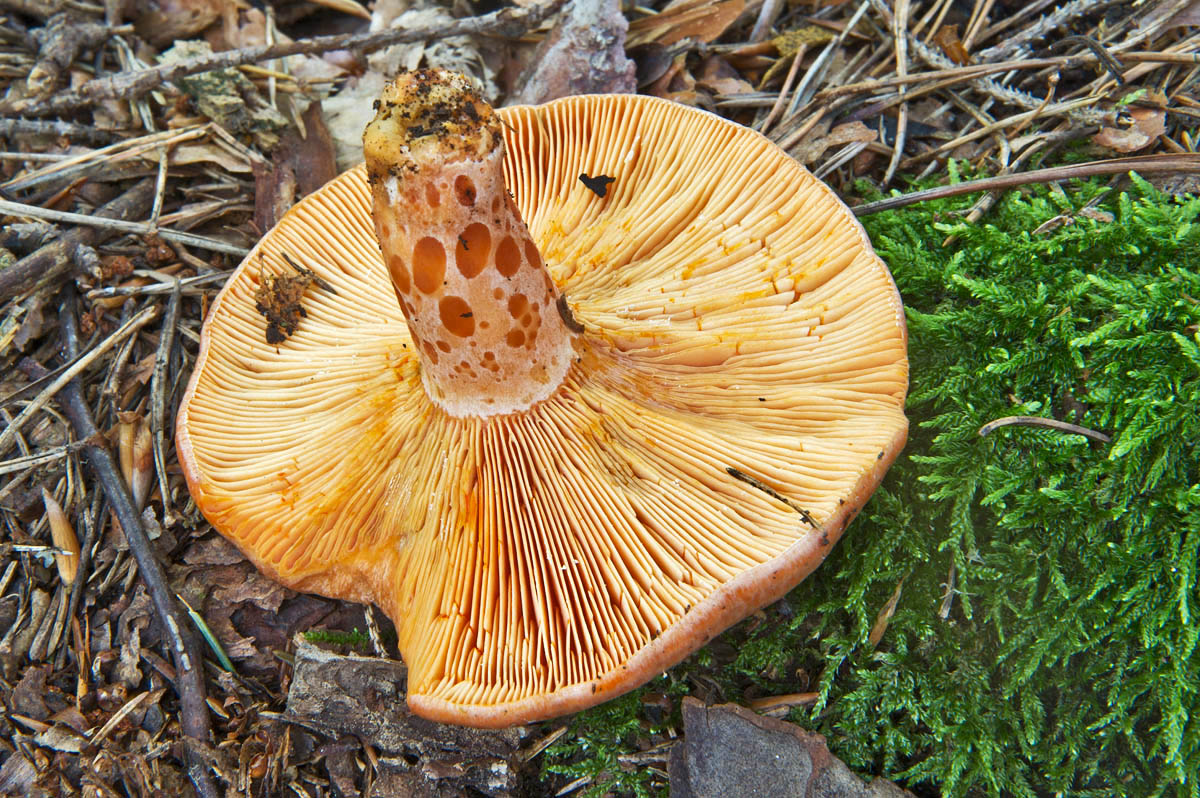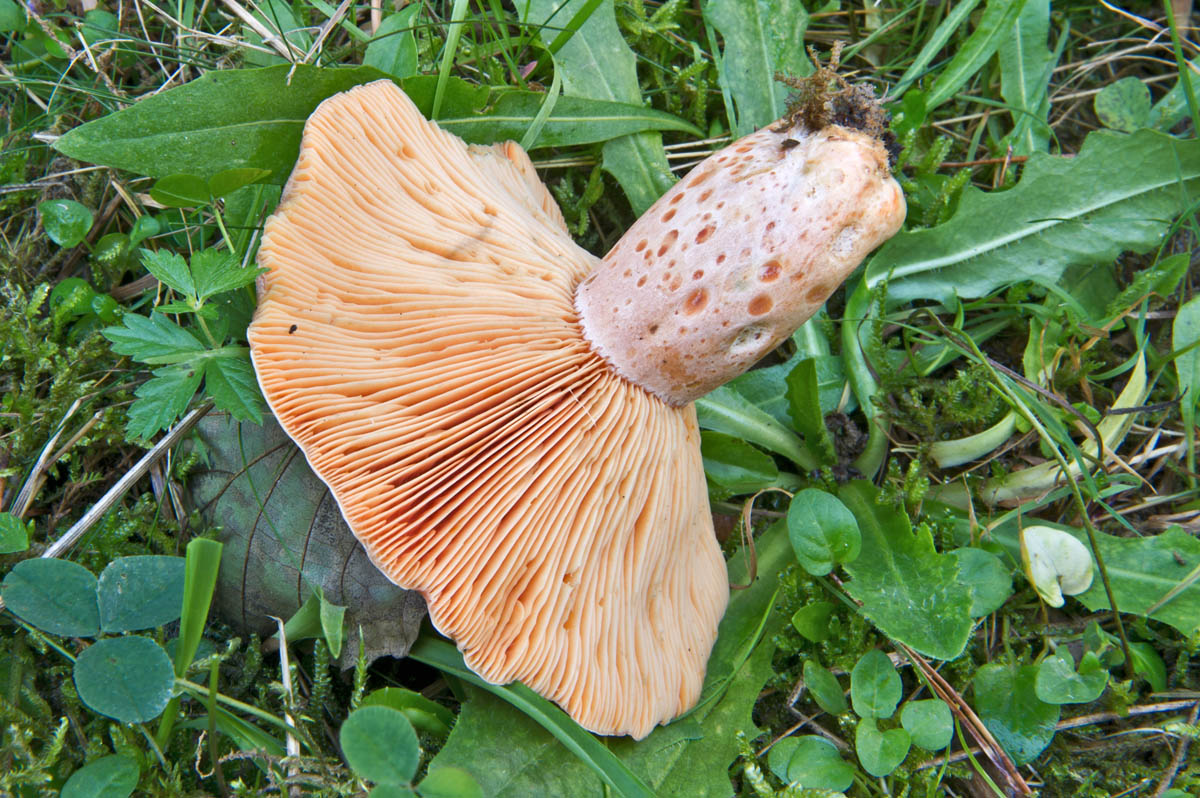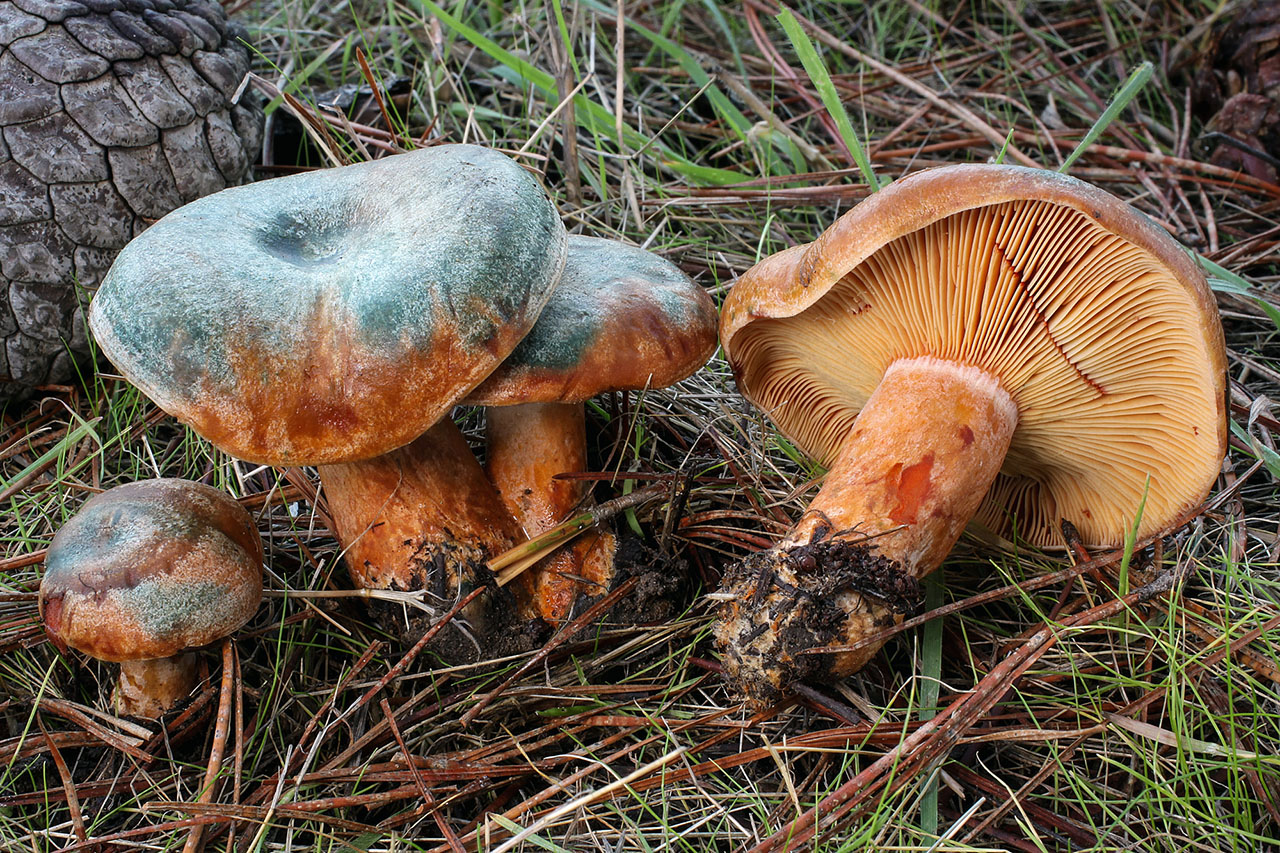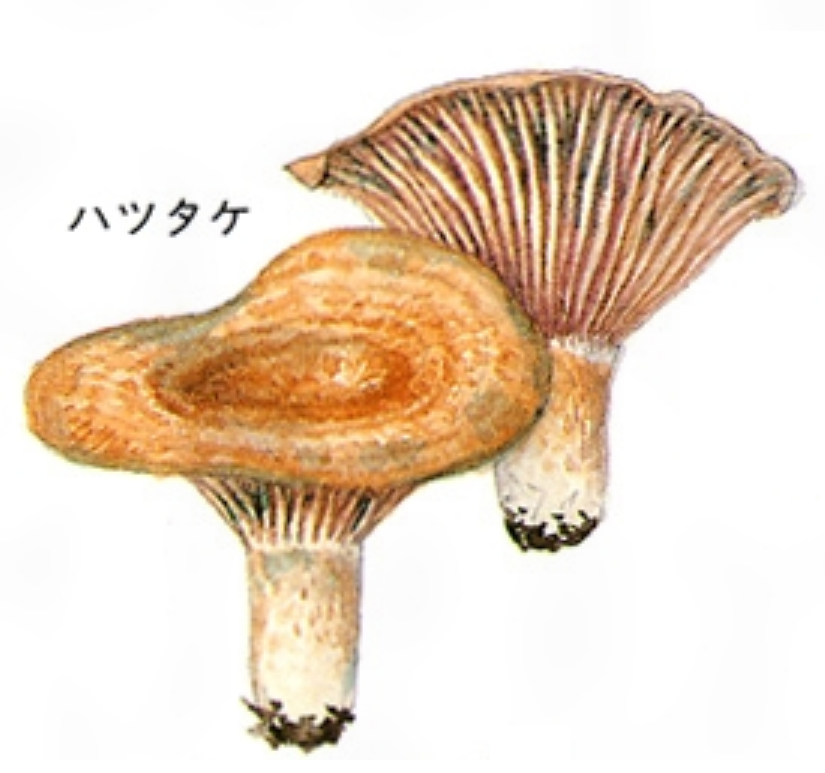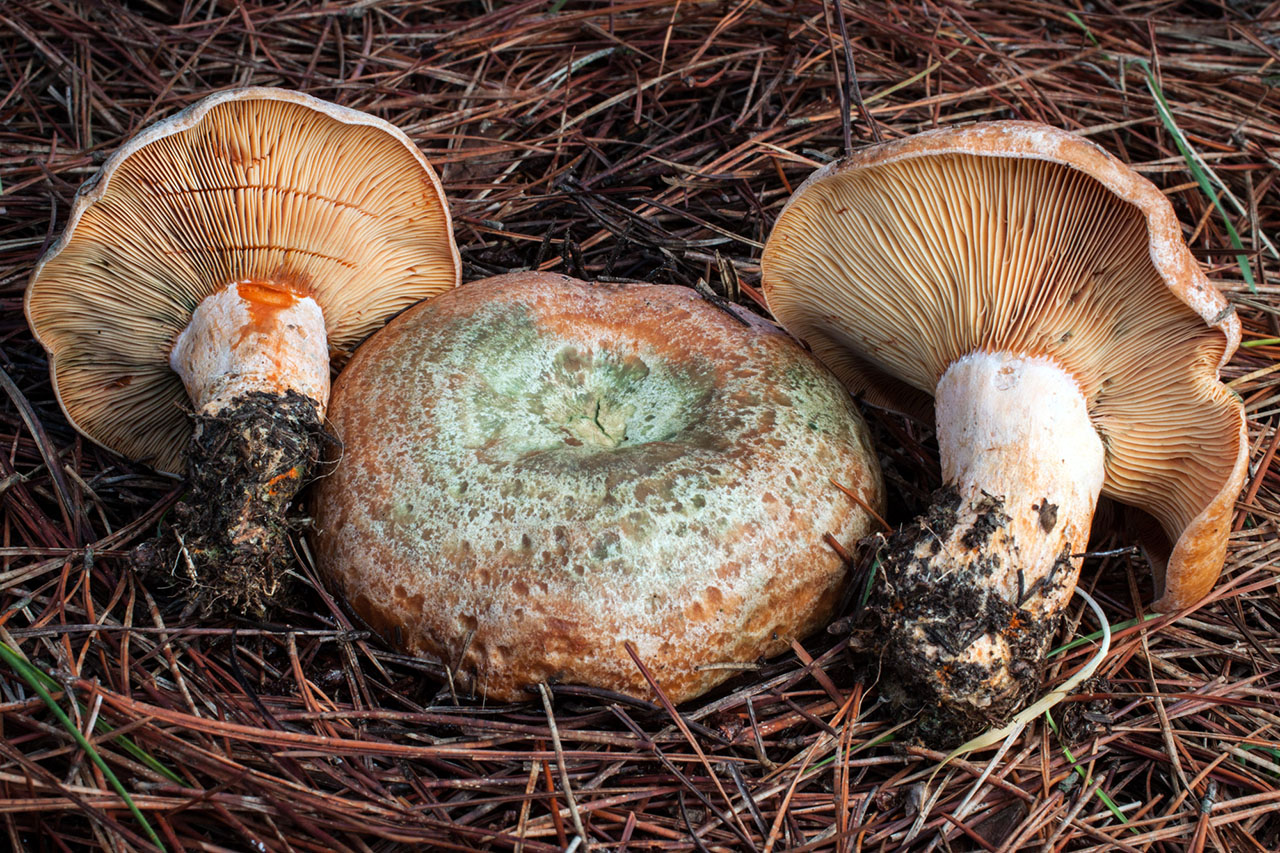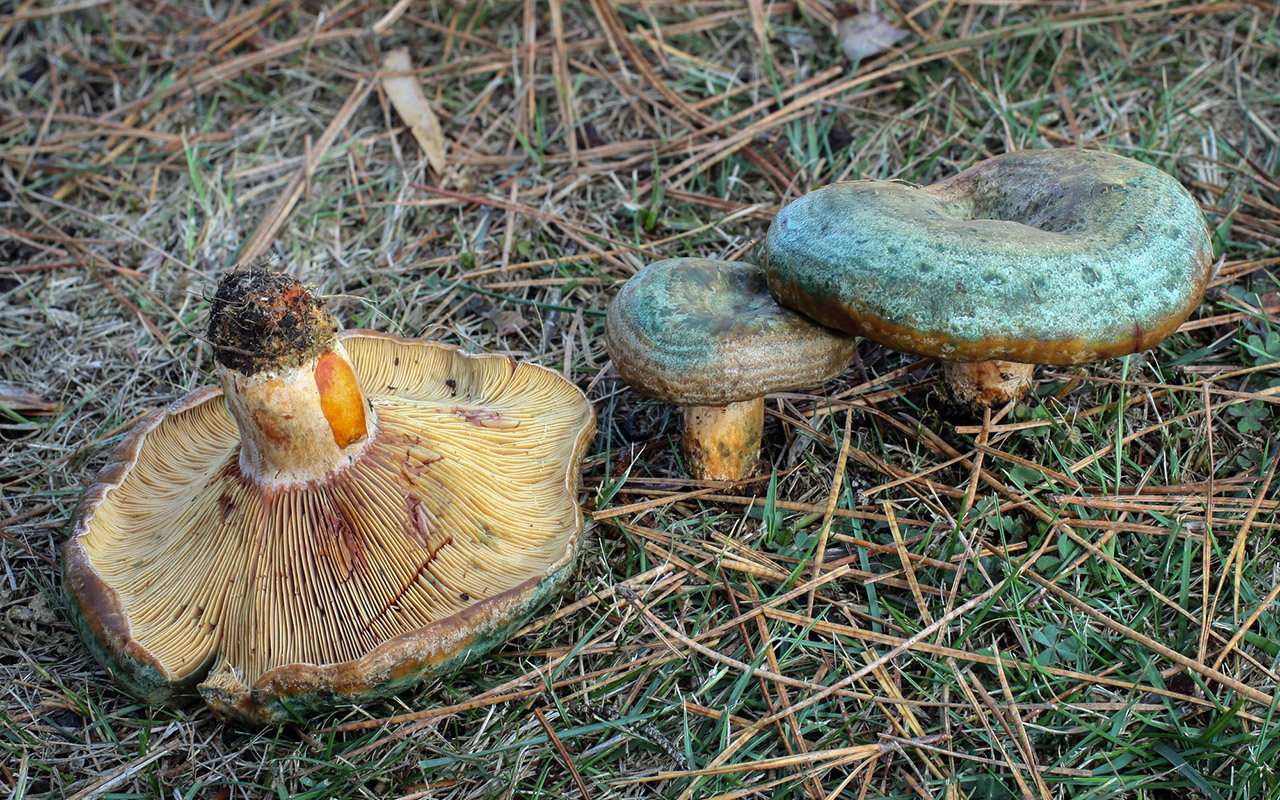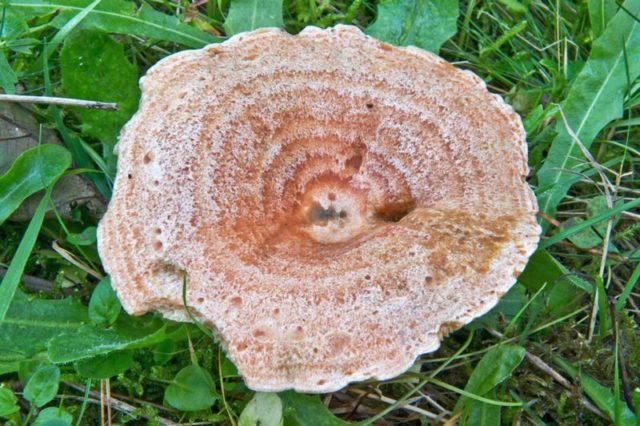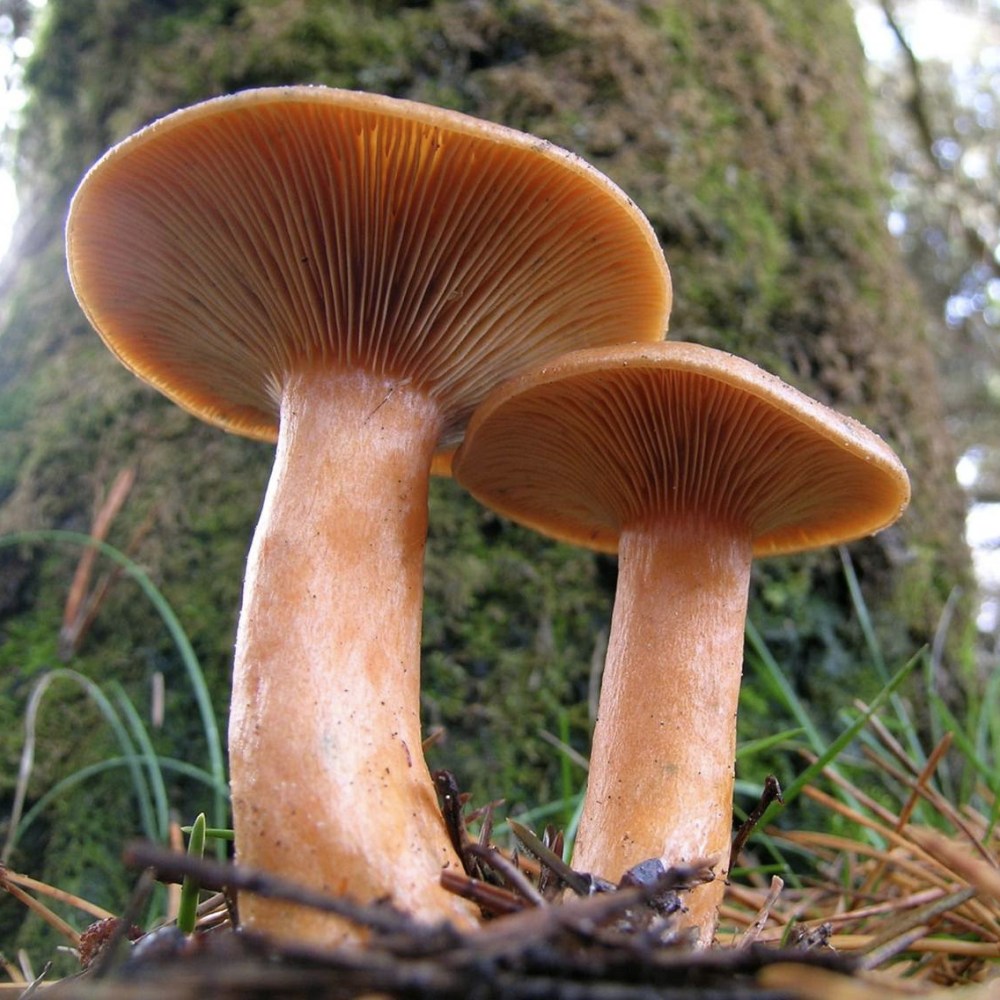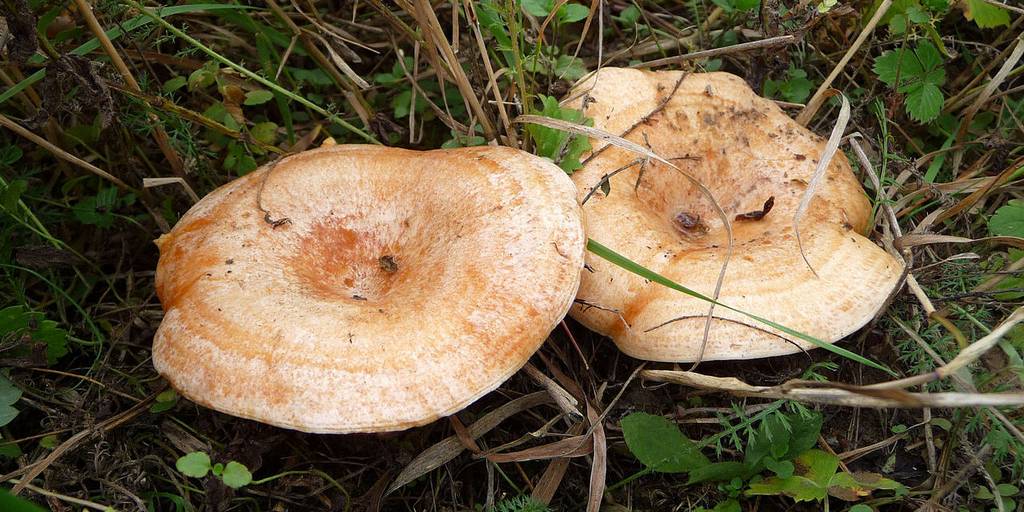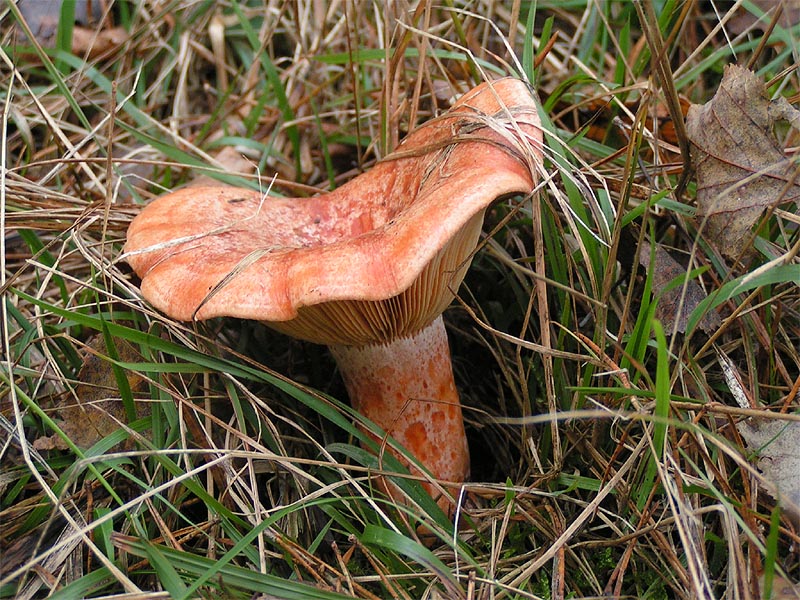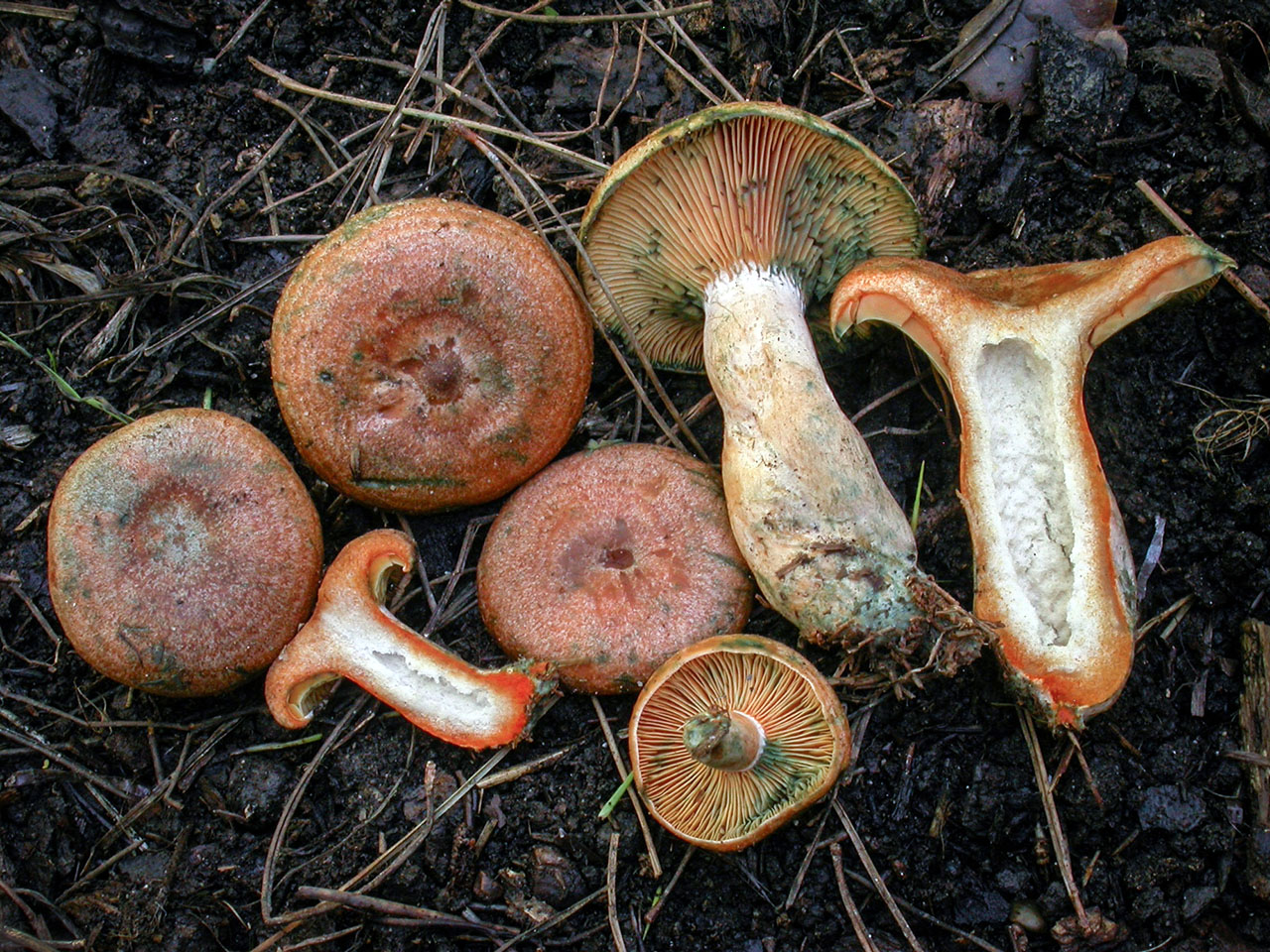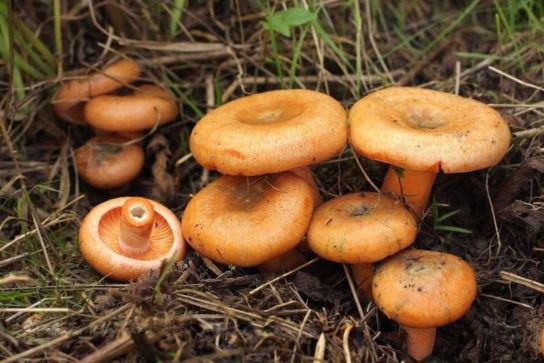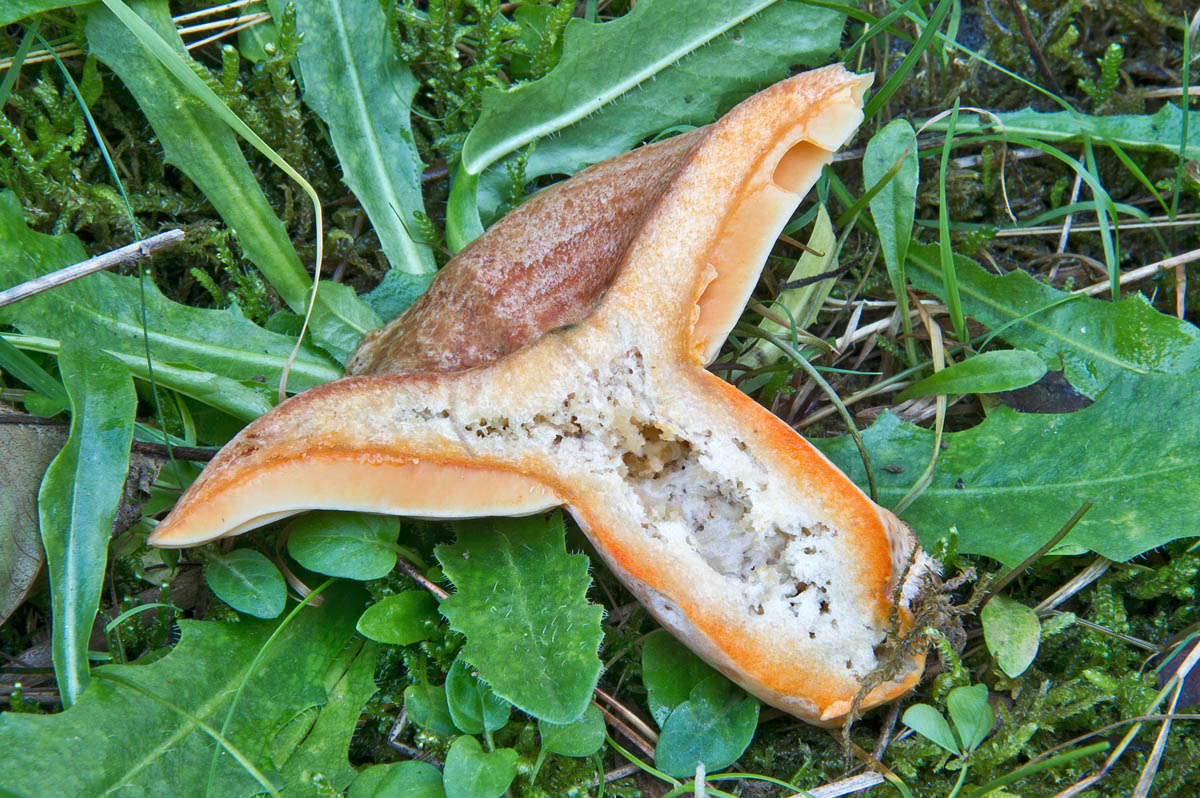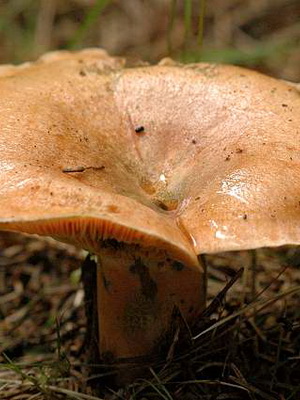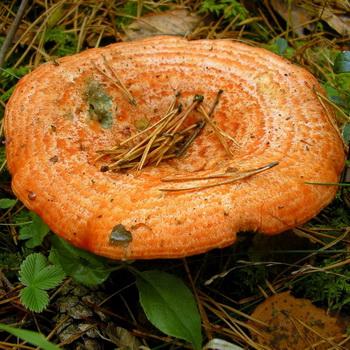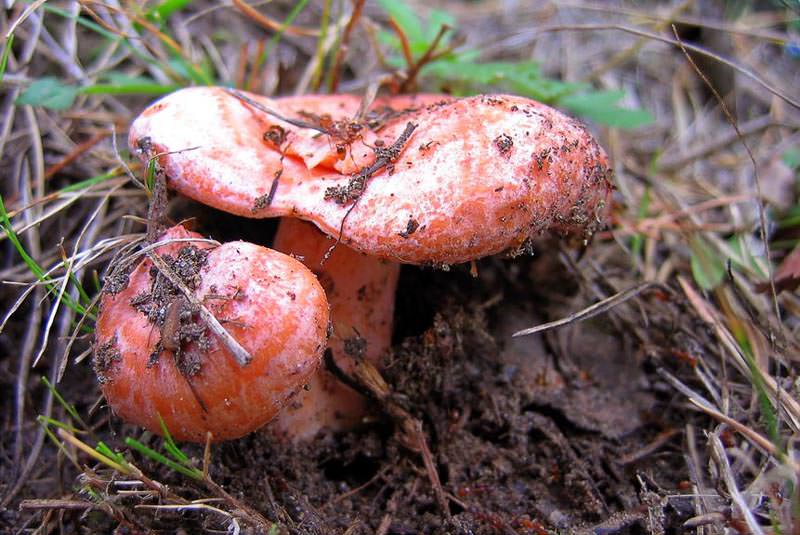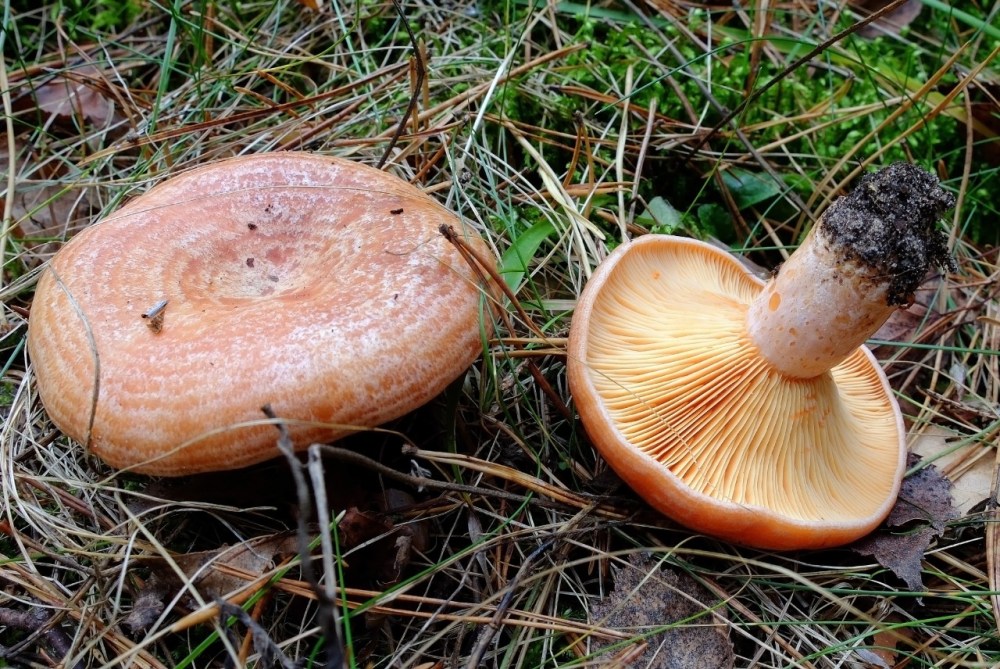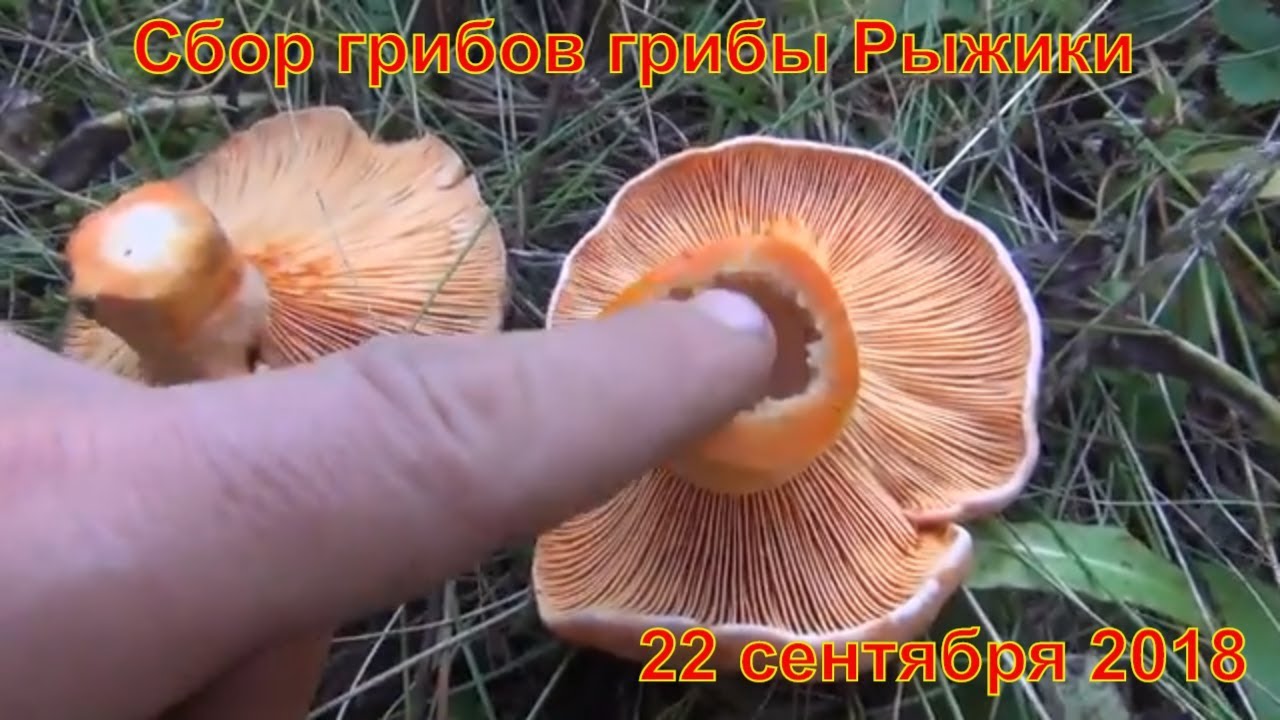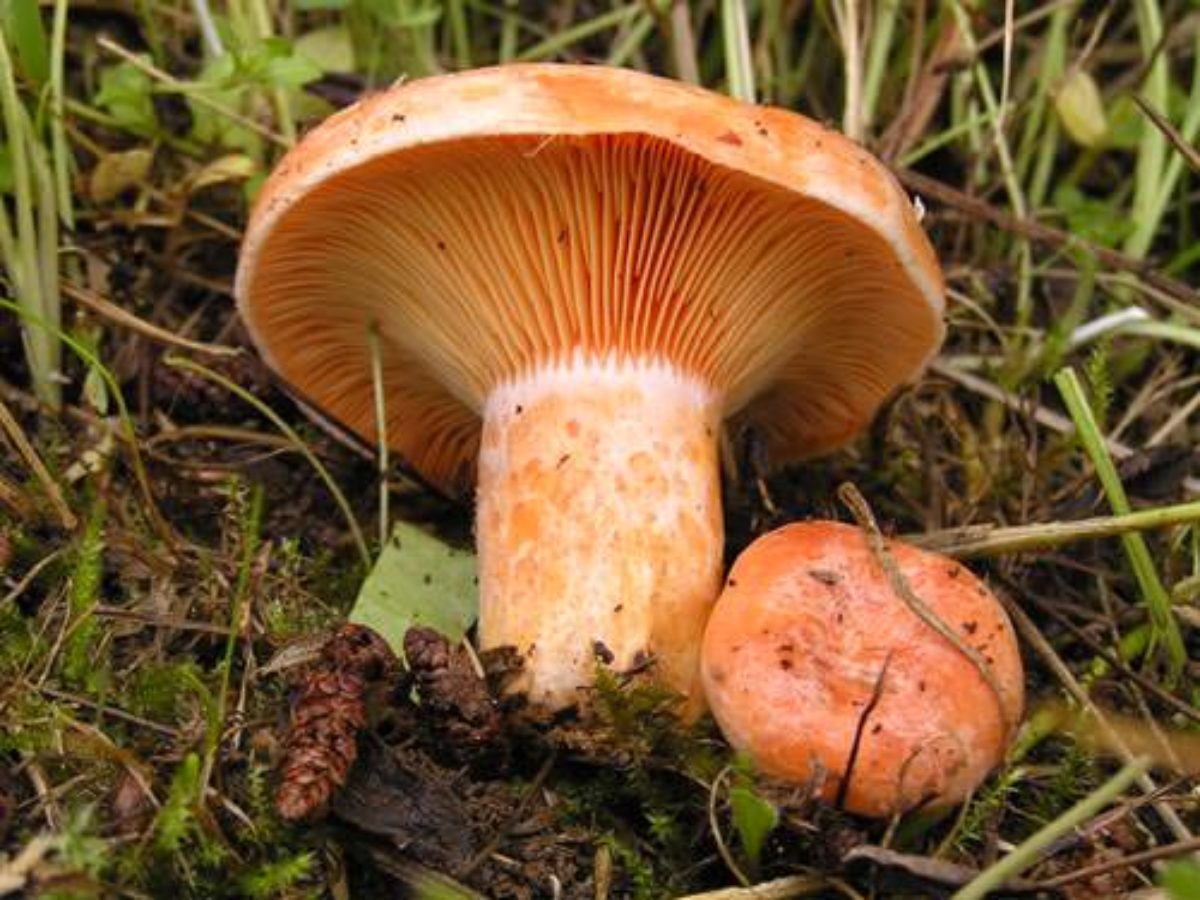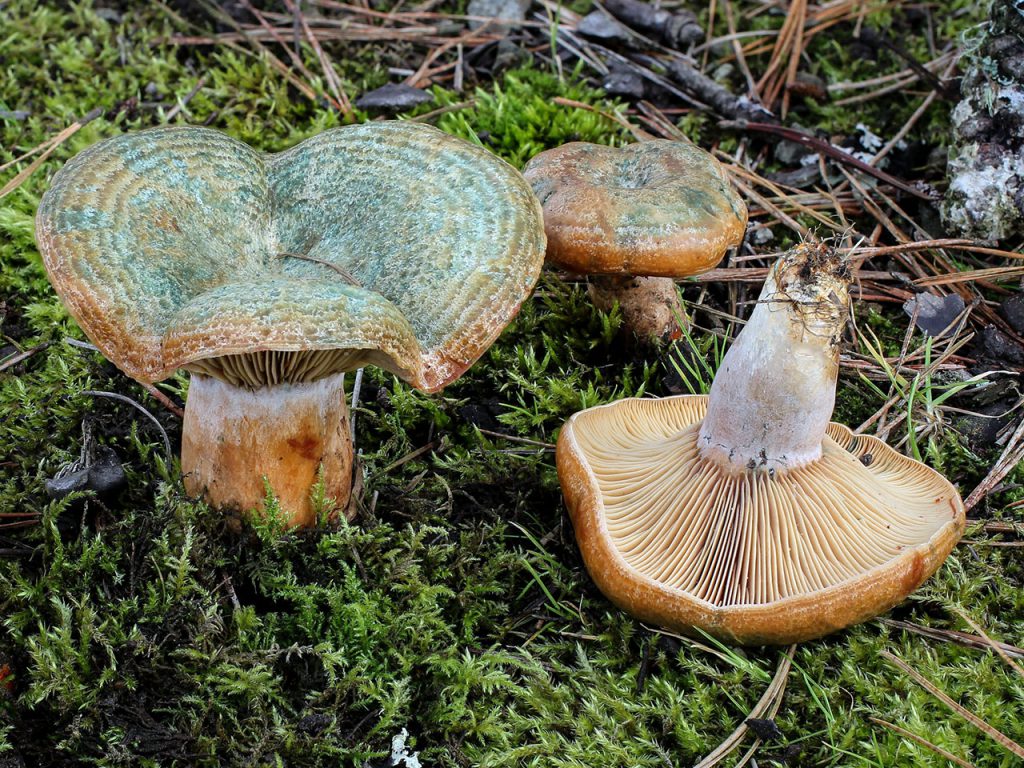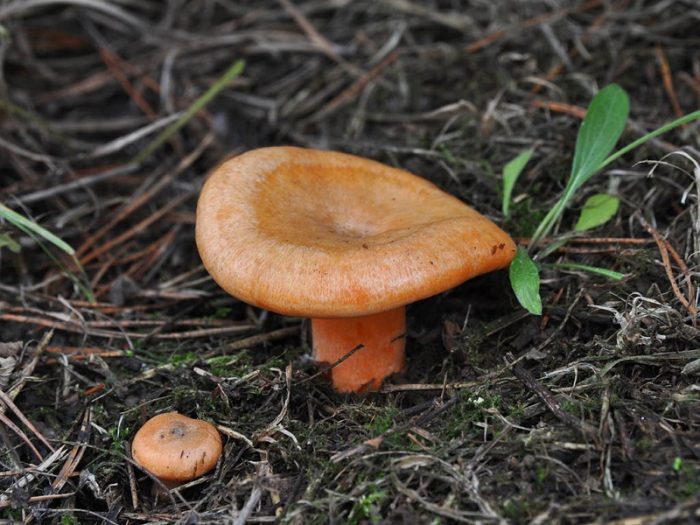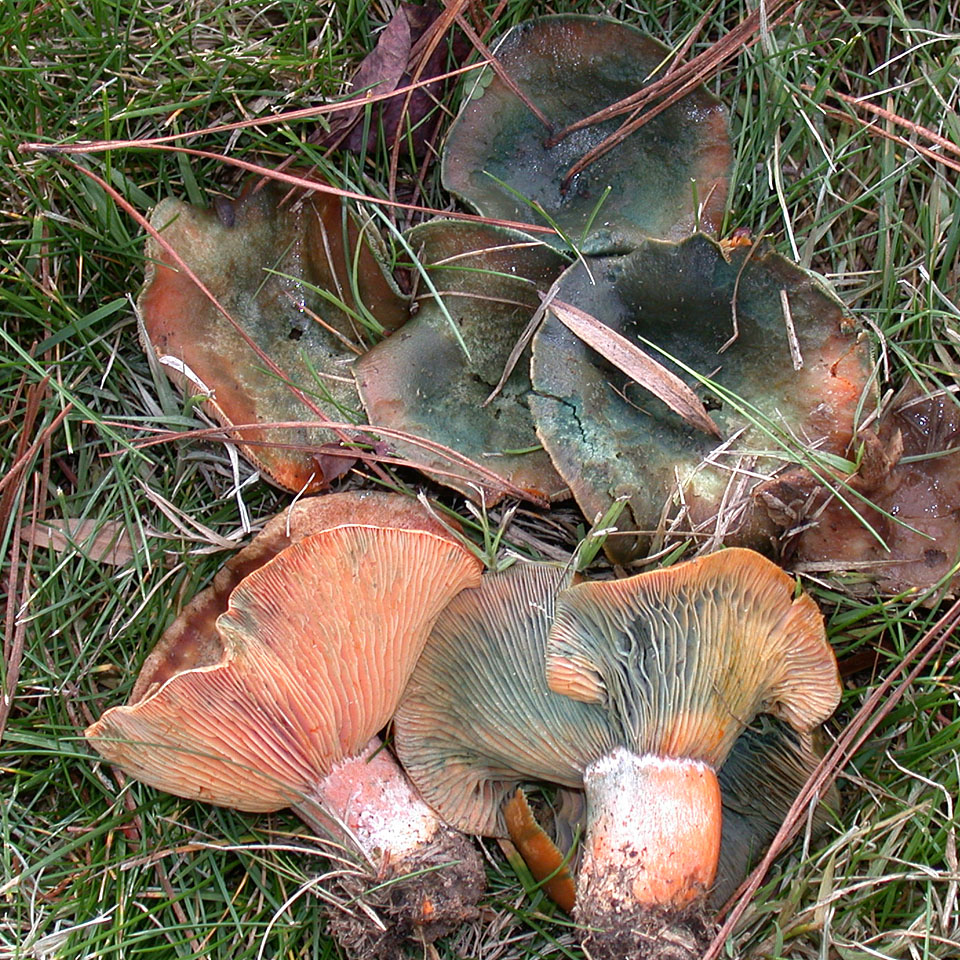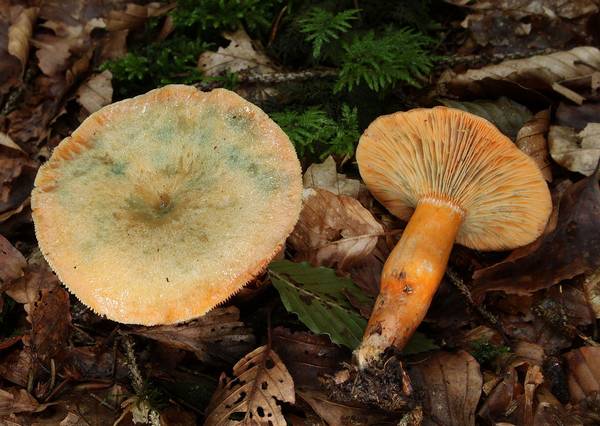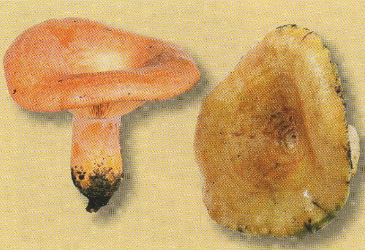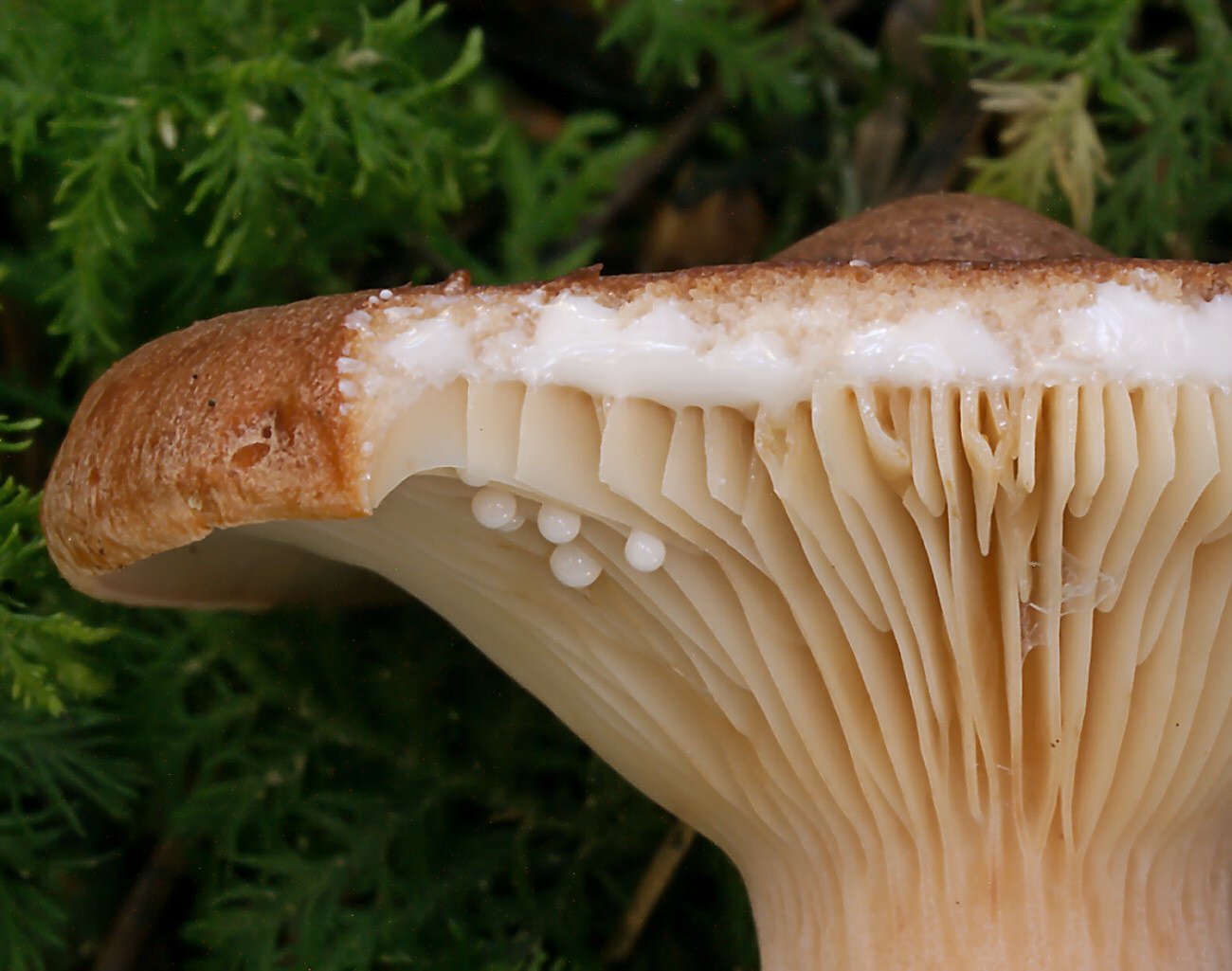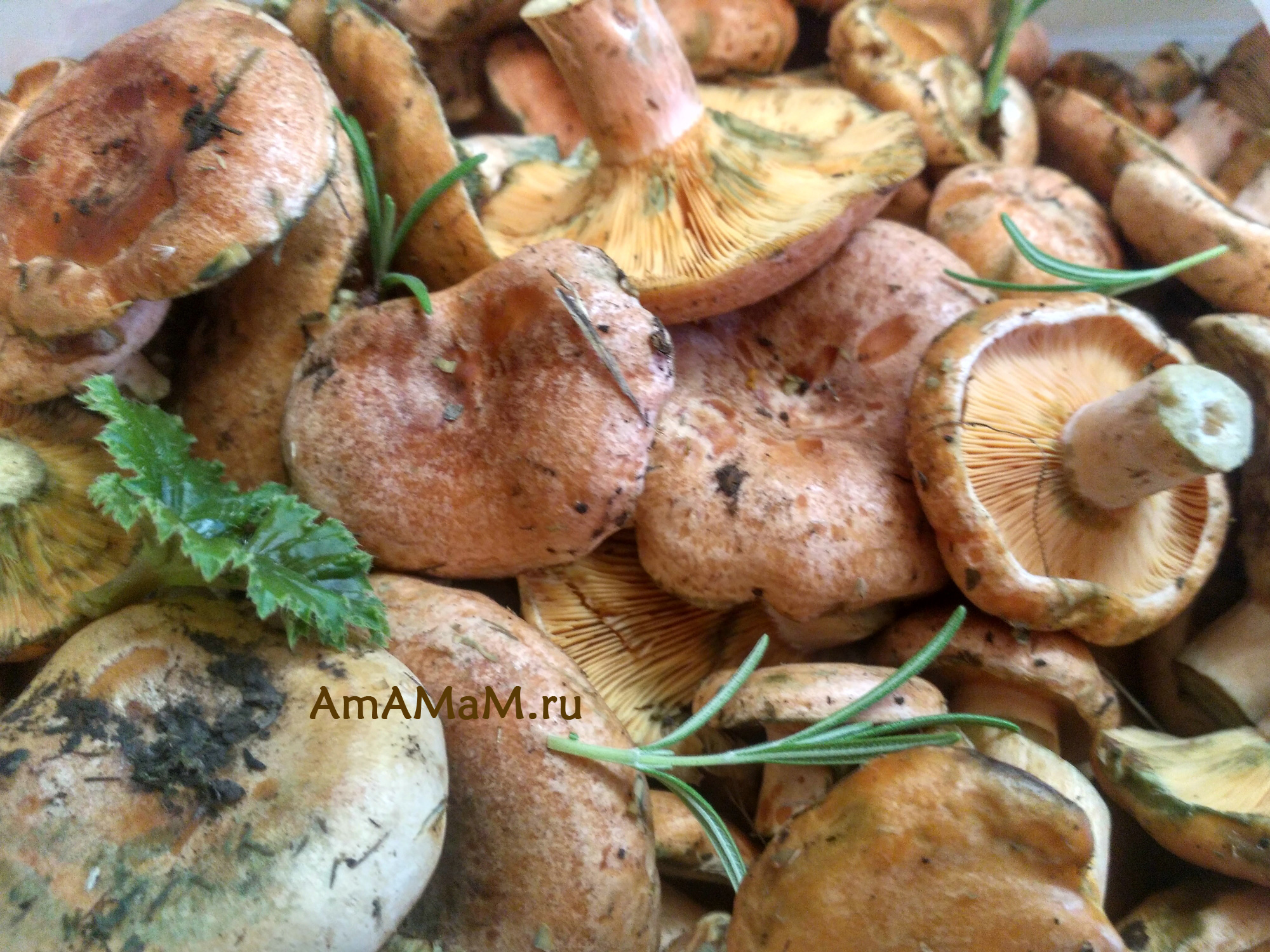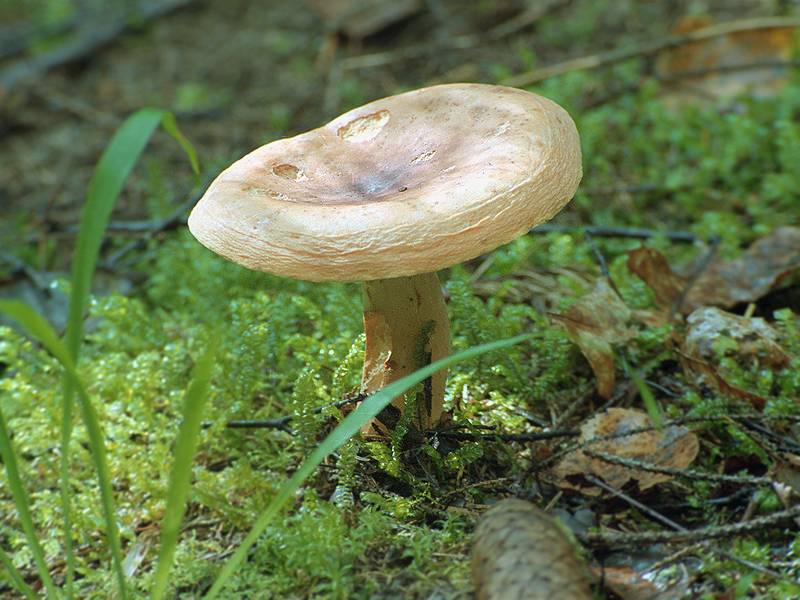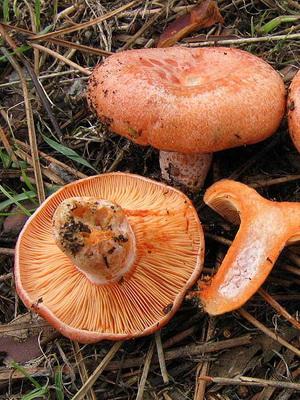Botanical description
Ryzhiks got their name from their bright orange, and sometimes even reddish hue, due to the high content of beta-carotene, which in the body turns into retinol or just vitamin A.
The cap of these representatives of the mushroom kingdom ranges in size from 4 to 14 cm. The color is bright from ocher-yellow to dark orange, shiny. The shape is spherical, convex. A depression may form in the middle, and the edges of young mushrooms are tucked up. With age, the edge of the cap straightens, and it acquires a funnel-shaped shape. The surface is smooth, sticky, slightly slippery. There are girdle rings on it, sometimes a whitish bloom. At the bottom of the cap there are many thin orange-red plates that acquire a green tint when pressed.
The leg is small and thin, its height is from 3 to 7 cm, its thickness is up to 2 cm. It coincides in color with the cap, differs only in a lighter shade. Inside, they are hollow, narrowed at the base, small darker grooves are characteristic of the upper part.
The flesh of the saffron milk caps is dense, bright orange in color, turns green when broken.
A thick milky juice is released. It also has an orange color, which turns green when exposed to oxygen.
Characterized by a fruity sweetish odor.
Common types of saffron milk caps
Among the types of saffron milk caps, the three most common are distinguished: spruce, red, real. They are distinguished by some differences in appearance and places of growth.

Real. It is known as pine mushroom, common mushroom, autumn mushroom, noble mushroom.
The hat is shiny, rather large, up to 14 cm in diameter. Convex, round shape. Its surface is of various shades - from orange to red. On the surface there are girdles, sometimes a whitish coating. The edges curl inward, mostly in adult mushrooms.
The leg is thick, high - up to 10 cm in length. Its surface is rough, it can be covered with a small fluff.
The plates are bifurcated, thin, extend onto the base of the peduncle and can occupy no more than 1/3 of its entire length.
Collected in moss from June until frost.
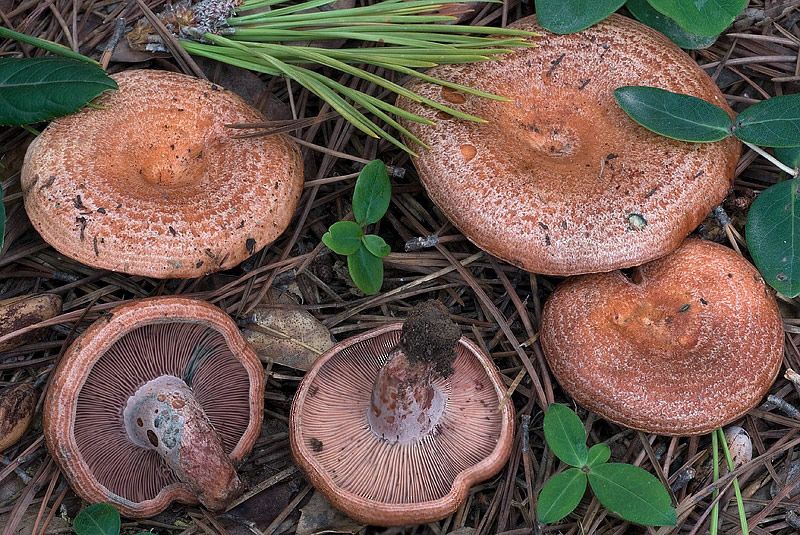
Red. Less common than other species. It is distinguished by a flat, wide, shiny, large cap, reaching a diameter of 17 cm. It has a depressed fossa in the center. The hat is fleshy and has an orange-red color. On contact with water, it does not lose its density and does not become slimy. The edges of the cap in young mushrooms are bent, and in adult specimens they do not bend at all. The difference from other species is the absence of circles of spots.
The leg is dense, strong, short, only up to 6 cm in length. There is a mealy bloom and red grooves. The pulp is dense, brittle, white, with randomly located bright red spots. Characterized by a viscous milky juice of a bright red hue at the fracture site. The plates are narrow, frequent, strongly descending along the stem.
Prefers coniferous bedding. It is found mainly in high-mountainous areas from June to September inclusive.

Japanese mushrooms (lat.Lactarius japonicus),
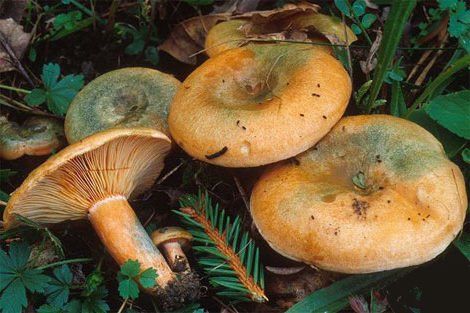
Spruce. Has a relatively small size. Its cap usually does not exceed 8 cm in diameter, the height of the leg ranges from 2 to 6 cm, and its diameter reaches only 1 cm. The spruce mushroom cap is sticky, light orange with a greenish tinge. When ripe, it brightens. The leg is thin. The pulp with a pleasant smell, fragile, at the cut site first acquires a reddish tint, and then turns green. This mushroom is found under spruce trees in a mixed forest from July to September.
False doubles
The uniqueness and recognizable appearance do not allow the mushroom to be confused with other representatives of the mushroom kingdom. But among the varieties of these mushrooms there are some that are not edible mushrooms.They belong to the 4th class - conditionally edible mushrooms. These representatives are called false doubles of the saffron milk cap. These include:

The miller is fragrant. A small, brown cap is characteristic, up to 5 cm in diameter. Its edges at any age of the fruiting body are concave inward and slightly torn along the contour. The smell is spicy, very strong, like a coconut. They are used in cooking, salted or dried, as a spice for dishes.

Milk papillary or large lactic acid. It is a conditionally edible mushroom. Grows in coniferous forests. The hat is gray-brown in color, small in diameter. The pulp is brittle, white, pleasant smell. Milky sap is white, does not change color when broken. It is recommended to use it as a food product only after thorough soaking and prolonged salting.
Contraindications
Ryzhiks, like other mushrooms, have a number of contraindications to their use. It is not recommended to include them in their diet for people suffering from:
- pancreatitis;
- cholecystitis;
- low levels of gastric acidity;
- chronic constipation.
Also, you should not eat mushrooms with individual intolerance to this product and after removal of the gallbladder.
Due to the high calorie content, use salted and pickled mushrooms with caution in food for people suffering from overweight
Cooking secrets
Ryzhiks do not require pre-soaking. The washed fruit bodies should be doused with boiling water and wait until they let the juice out. Then dip them into salted water. These mushrooms are usually boiled for 15-20 minutes. Ryzhiks go well with sour cream, potatoes and vegetables. In cooking, they are also used for making soups, fillings for pies and dumplings.
Pickled mushrooms are a very popular and tasty appetizer. The first step is to prepare for pouring:
- sort out and clear mushrooms from debris;
- rinse in cold running water;
- make the necessary trimming of the leg, but not more than 3 cm;
- sterilize banks.
For 2 kg of mushrooms you will need:
- 300 ml of water;
- 15 g salt;
- 300 g citric acid.
First, the marinade is prepared. To do this, put citric acid and salt in boiling water. Put cooked mushrooms in a boiling marinade and cook for 15 minutes. After that, arrange them in prepared jars along with the marinade. Roll up the cans, turn upside down and let cool. In such a snack, useful substances that are rich in mushrooms are preserved.
For salting saffron milk caps, wooden barrels are usually used. First, prepare the barrel. To do this, boiling water is poured into it and wrapped for 30 minutes. warm material. Distantly peeled and washed mushrooms are placed in layers in a barrel, shifting them with dill sprigs, horseradish leaves, oak leaves, cherries and cloves of garlic. From above, the mushrooms are covered with gauze and salt and pressed down with a heavy load. The mushrooms are salted for two months.
Ryzhiki in sour cream. Main Ingredients:
- 1 kg of saffron milk caps;
- 250 g 20-25% sour cream;
- 1 onion;
- garlic to taste;
- condiments and spices.
Rinse the mushrooms and remove debris. Cut into pieces. Cut the onion into rings and squeeze out the garlic. Add spices, seasonings and salt to sour cream. Grease a frying pan with vegetable oil and fry the mushrooms for 5-10 minutes. Add onion and add 50 g of water. Cover and reduce heat. After the water boils away, and the mushrooms and onions are fried until golden brown, they need to be poured with sour cream. Add garlic and simmer over medium heat for about 10 minutes.
Ryzhik (mushroom): photo and description. What do mushrooms look like?
Gingerbreads are cap mushrooms, they have a well-formed fruiting body, consisting of a cap and a central leg, which are tightly connected to each other. Their separation does not occur without tissue rupture.
The cap of young saffron milk caps at first looks like a cap, it is hemispherical, often flattened from above, velvety, later convex with thin edges slightly curled towards the stem, or convexly outstretched. As it develops, it changes to funnel-shaped with a straight thin edge, sometimes with a small tubercle in the center. Its diameter is from 1-3 cm to 20 cm.
The color of the cap and the entire fruiting body of the saffron milk cap has a protective coloration. The brightest mushrooms are those that hide in the grass under the fir trees. Depending on the place of growth, the cap can be yellowish-ocher, gray-olive, dark orange, blue, sometimes fading to whitish (in pine and spruce forms) with darker green or red-brown concentric circular zones (rings). The surface of the cap is smooth, bare or velvety (felt), glossy or dry, after rain it is sticky and slimy.
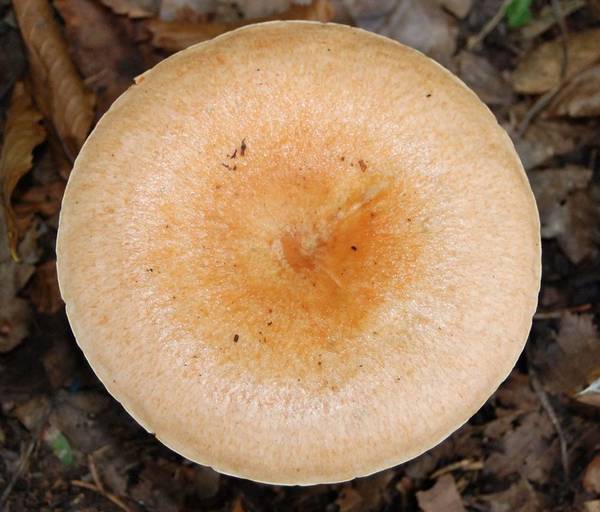
Photo by: Eleassar, CC BY-SA 3.0
Camelina stalk 4-6 cm long, 1-2.5 cm in diameter. Initially filled, then cellular, almost hollow, brittle. She is the same color as the hat or a little lighter, at the top under the plates lighter, tapering to the base or regular, cylindrical.
Its surface can be pubescent and covered with dark green spots and small pits, darker than the rest of the skin of the leg. When squeezed, the leg turns green.
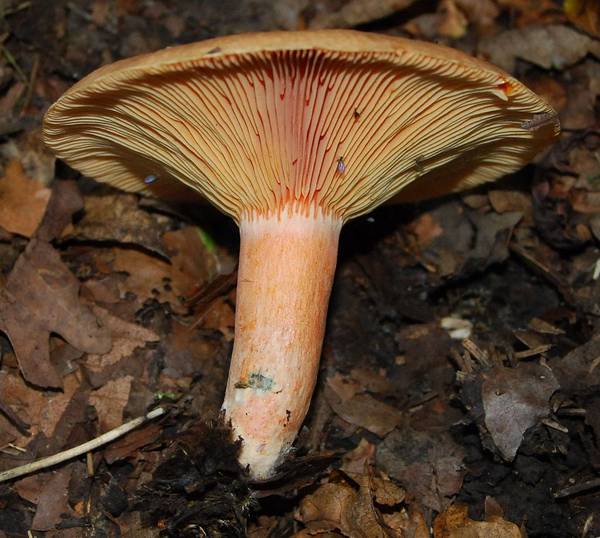
Photo by: Eleassar, CC BY-SA 3.0
The flesh of the saffron milk cap is dense, light, often changes color in the air, turns green or red. In the leg, it is whitish, at first it turns red on the cut, then it can turn green. Camelina pulp contains groups of rounded vesicular cells, spherocytes, which is why it is usually brittle. It also contains conducting ("vascular") hyphae with milky juice, which can be abundant or insignificant, watery or thick. Its color is orange, constant or slowly changing in air. In oak milk cap it is white. Mushroom juice is not acrid, but tart and often sweet.
Ryzhiks absorb forest aromas, therefore they become fragrant, giving off a fruity, resinous or mossy smell.
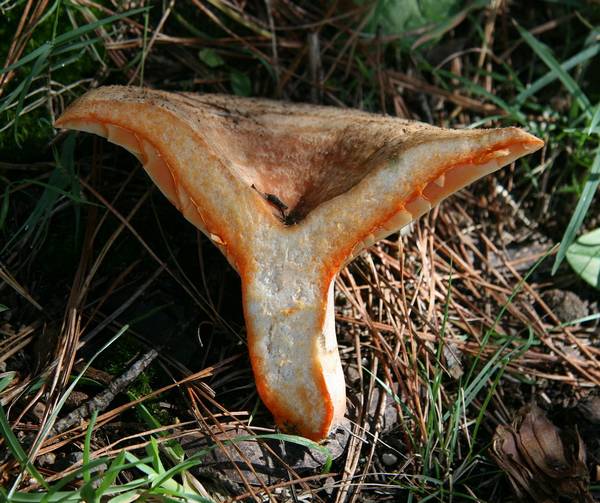
Photo by: Casliber, CC BY-SA 3.0
The hymenophore in saffron milk caps is lamellar. The plates are frequent, thin, bifurcated, slightly descending on the pedicle.
First yellowish, later orange, turning green from squeezing, and then becoming dark olive. They do not separate from the cap.
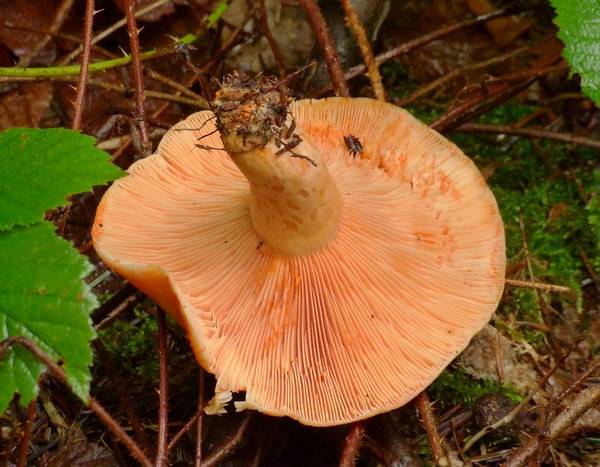
Photo by: Niepokój Zbigniew, CC BY-SA 4.0
Spore powder yellow, yellowish cream or light ocher.
The taste of mushrooms can be mild, sweetish, bitter, tart, astringent, or sour.
Cooking recipes
The fruits can be simply fried in sunflower oil, pickled, fermented, stewed, salted, caviar and soup can be prepared.
Pickling
For this cooking method, you need to pre-process the product. To do this, take 2 kilograms of raw mushrooms, completely cut off the legs, peel and rinse. Salt water (2 liters), then cook the fruits in it for about 20 minutes, then strain.
Cooking the marinade: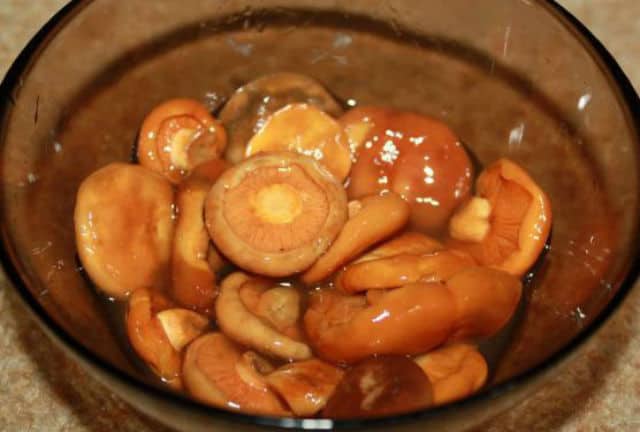
- 0.5 liters of 9% vinegar;
- 0.5 liters of water;
- 2 tablespoons of salt;
- 1 tablespoon sugar
Cooking process:
- Bring the mixture to a boil.
- Cook the mushrooms in it for about 20-25 minutes.
- In the process, add a pinch of black pepper, cloves and cinnamon, laurel leaf.
- We quickly transfer the product to sterilized jars while they are hot.
Stewed mushrooms
In the process of frying, the mushrooms should be covered with a lid, they will be stewed in their own juice. Along the way, you need to add liquid - vegetable or meat broth, cream, milk, sour cream, tomato juice or soy sauce. To thicken the gravy, the fruits are rolled in flour before frying.
The signature recipe for stewed mushrooms with sour cream and cheese (this was the favorite dish of Tsar Peter 1!):
For this you will need:
- 1 kg of mushrooms;
- 2 medium-sized onions;
- 200 grams of sour cream;
- 50 grams of butter;
- flour for breading;
- spices.
Preparation:
- Clean the fruits of debris and rinse in a bowl of water.
- Cook for 15 minutes.
- Throw in a colander.
- Chop.
- Chop the onion with a knife and fry in butter.
- Sprinkle the mushrooms with flour, add to the onions, fry until the liquid evaporates.
- Add sour cream, reduce heat and simmer, covered, for 14 minutes.
- Add grated cheese and bake in the oven, multicooker or microwave for 10 minutes.
The dish is ready.
Salting
With this type of processing, mushrooms are especially tasty.There are two ways to salt them.
First:
- We clean, remove wormy and rotten ones, wash.
- We spread in layers of 8 cm with the hats down.
- We fill each layer with salt - at the rate of 50 grams per 1 kg of product.
- Cover the top with a plate wrapped in cloth, which we press down with oppression to seal the mushrooms.
- After 24–48 hours, the mushrooms will give juice, and they can already be consumed. After all, they belong to the russula family and are salted as quickly as cucumbers and tomatoes.
Second method:
- Boil the washed fruits for 5 minutes.
- We put it on a sieve or colander.
- We spread it in a container in even layers, filling each one with salt, bay leaves, pepper, chopped garlic and dill sprigs.
- We press down with oppression and put in the refrigerator or basement for 45 days.
Pickled pine mushrooms
For this method, we use only hats. Pickled mushrooms are considered even healthier than salted ones, since lactic acid promotes better absorption.
Cooking process: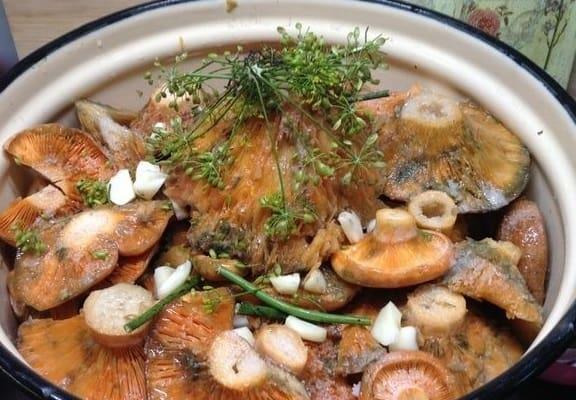
- We wash the hats, fill them with boiling water and put them in a colander.
- Preparing the fill - mix water, salt, sugar and whey.
- We spread the product in a previously prepared container, fill it with salt and pour in the marinade.
- We press the mushrooms with oppression so that they always remain in the liquid.
After 2-3 weeks, you can eat.
General characteristics
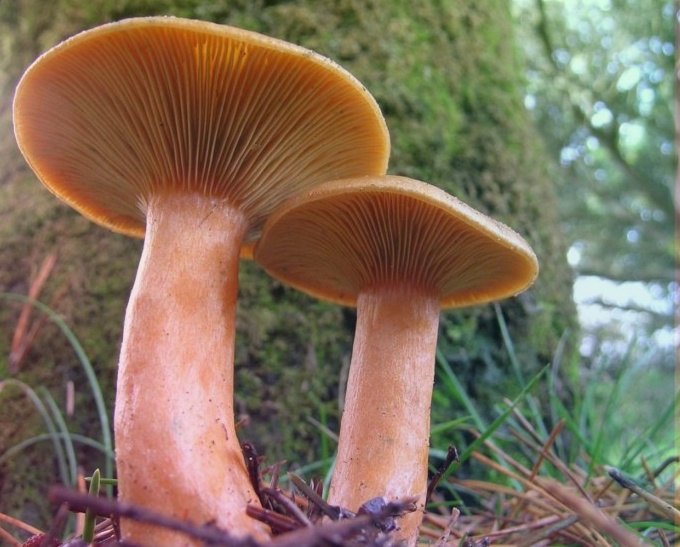
Ryzhiki - royal mushrooms of the Russian forest
Gingerbreads are a whole group of mushroom species from the genus Millechnik or Lactarius, the russula family. They got their name for their characteristic red - yellow - orange color. Their milky sap is also colored in various shades of red. The mushrooms got their characteristic color due to their high content of beta - carotene - in other words, vitamin A. They also contain ascorbic acid, niacin, riboflavin, thiamine, and many healthy minerals. The natural antibiotic lactrioviolin, which suppresses the growth of pathogenic bacteria in the body, and is used in medicine to fight many inflammatory diseases, including tuberculosis, is of particular weight in this case.
Ryzhiks are very good and tasty edible mushrooms, hotly appreciated by gatherers and experts in mushroom cuisine, they are easily assimilated by the human body, and in terms of protein content they are not inferior to meat.
They are also a high-calorie product that surpasses even beef and chicken eggs in energy value.
In Russia, Ryzhiks have the nickname "Tsar's Mushroom", it is known that they were highly revered at the imperial court, and were regularly supplied to the tsar's kitchen.
These mushrooms grow from the first half of summer to the second half of autumn, but since ancient times in Russia there is a saying that summer mushrooms are suitable only for frying, but autumn mushrooms are good in any form.
The mushrooms bear fruit successfully at temperatures above +10 degrees and humidity of 50-60%, and are very fond of abundant rains, therefore they grow especially rapidly in the autumn season.
Preparation
Mushroom recipes mushroom dishes there are many, but in most cases they prefer to salt or pickle
Pay attention to several successful options for how to cook mushrooms at home so that they retain useful substances and trace elements
Salting
If a large crop of camelina has been harvested, they can be cold salted. Such preparation does not involve the use of vinegar, so the appetizer turns out to be not only royally tasty, but also healthy.
Ingredients: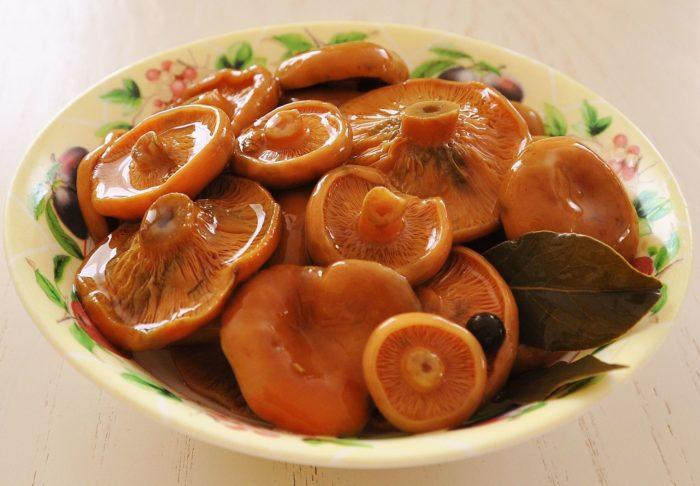
- 1 kg of fresh mushrooms;
- 40 g salt;
- currant and laurel leaves;
- allspice and black peppercorns to taste.
Preparation:
- Put the peeled mushrooms on a sieve and pour over boiling water twice. Then they are washed with cold water and allowed to dry.
- Salt mixed with spices is placed on the bottom of a wooden barrel or enamel container.
- Next, spread the mushrooms, placing them with their caps up. The thickness of each row is no more than 7 cm. The layers are sprinkled with salt and pepper.
- The remaining spices are placed on top.
- The workpiece is covered with a clean towel, a wooden circle is placed on top and oppression is placed.
- The container is taken out to a cool place.
- After a few days, the brine will appear. It must be drained periodically.
The mushrooms will be ready to eat in one to two months. In the future, they can be transferred to jars and stored under an airtight lid in the refrigerator.
Fried mushrooms
Ryzhiks can not only be salted, but also fried. A simple recipe loved by many - with onions and sour cream. Chanterelles are prepared in a similar way.
Products:
- 0.5 kg of mushrooms;
- 2 medium onions;
- 200 g sour cream;
- vegetable oil for frying;
- salt and pepper to taste.
Cooking step by step:
- Onions are cut into small cubes and fried until golden brown
- The peeled and washed mushrooms are cut into random pieces, lightly doused in flour and fried separately.
- Mix onions with mushrooms, add sour cream, salt and pepper.
It is better to serve the dish hot, garnished with fresh herbs.
Ryzhiki - edible mushrooms: photo and description
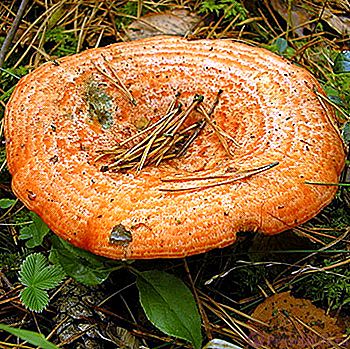
On this page you will find out when and in what forest mushrooms grow. And you will also see edible mushrooms in the photo with descriptions.
Where spruce mushrooms grow and photos of mushrooms
Category: edible.
Leg (height 3-8 cm): the same color as the cap, very fragile, cylindrical. In young mushrooms, it is solid, with time it becomes almost hollow.
Plates: very frequent, lighter than the cap, turn green when pressed.
Spruce Camelina Plates
Flesh: orange, but in the place of the fracture and when interacting with air, like the milky juice, it quickly changes color to red and then to greenish. Pleasant on the palate, with a fruity aroma.
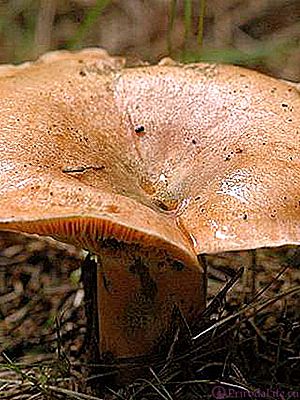
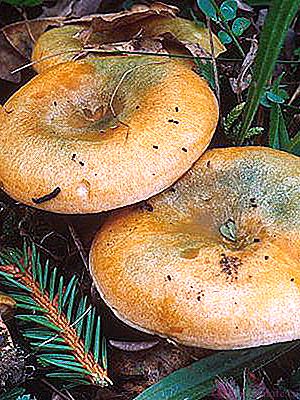
As you can see in the photo, the spruce mushroom (Lactarius deterrimus) has an orange cap, 3-9 cm in diameter, with a small tubercle in the center. Usually slightly convex, in old mushrooms with a greenish tinge, it may be slightly depressed or funnel-shaped. Very brittle, with slightly pubescent edges. Smooth to the touch, may be sticky in wet weather.
The description of the spruce mushroom is similar to the description of the pink wavelet (Lactarius torminosus) and the true mushroom (Lactarius deliciosus). However, the orange milky sap does not change color in the wave, and the real mushroom is smaller and grows in all types of coniferous forests.


You will find out where you can find mushrooms by going to the coniferous forest. From mid-August to the end of September, literally every spruce forest is covered with these mushrooms.
Eating: delicious in almost any form.
Application in traditional medicine: not applicable.
Other names: spruce, green mushroom.
Red mushroom mushroom: photo and description
Category: edible.
Cap of red saffron milk cap (Lactarius sanguifluus) (diameter 4-17 cm): orange or deep pink, very dense, open or slightly depressed in the center, often with curled edges.
Leg (height 3-9 cm): very strong, cylindrical in shape, expanding from bottom to top.


Pay attention to the photo of a red saffron milk cap: often its leg has small pits or a mealy bloom. Plates: frequent and not wide
Plates: frequent and not wide.
Flesh: fragile, whitish, with red pits and blood-red milky juice.
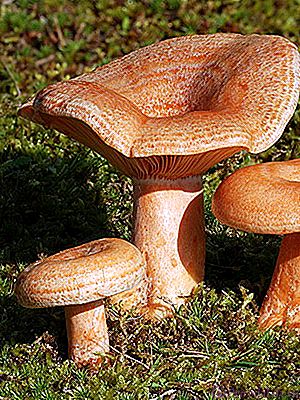

According to the photo and description, the red mushroom is very similar to the real mushroom (Lactarius deliciosus), but it has an orange-colored milky juice.
When it grows: from early July to mid-September in temperate countries of the Eurasian continent.
Where can you find it: on the soils of deciduous forests.
Eating: delicious in any form.
Application in folk medicine: not used, but scientists were able to isolate the antibiotic lactarioviolin against tuberculosis from red camelina.
Gingerbreads are real, and in what forest do they grow
Category: edible.
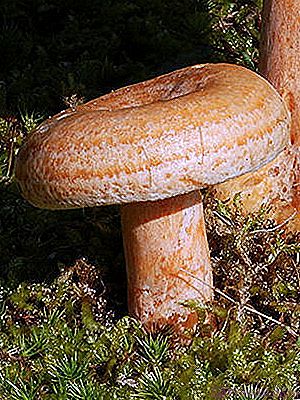

Cap of real saffron milk cap (Lactarius deliciosus) (diameter 5-14 cm): shiny, orange or reddish, can be ocher, dark yellow or red-brown. It has characteristic concentric rings and sometimes a white coating. Convex, but over time it changes to almost flat or even depressed. The edges are usually curled towards the inside.Smooth, slippery and slightly sticky to the touch.
Leg (height 4-10 cm): the same color as the cap, hollow, with small gouges. Expands from bottom to top. Maybe with a light fluff.
Plates: thin, the same color as the cap. Turn green from weak pressing.
Pulp: very firm, turns green at the cut site when exposed to air, has a slight fruity odor. The milky juice is light orange in color.
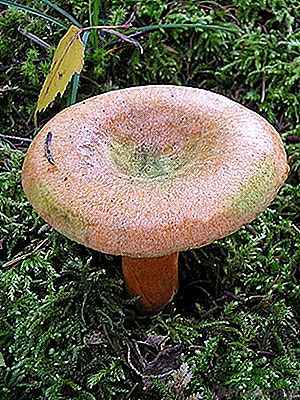
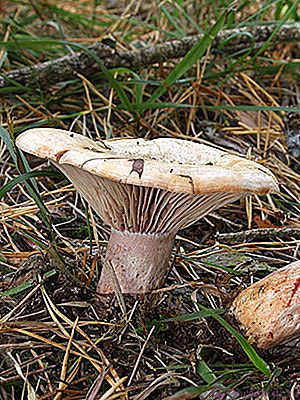
Camelina mushrooms by photo and description are similar to spruce mushrooms (Lactarius deterrimus), red (Lactarius sanguifluus) and Japanese (Lactarius japonicus). Spruce mushroom differs from the present in its smaller size, and also in that it grows exclusively under spruce trees. Red has no rings on its cap and has a rich red milky juice. Japanese produces a reddish milky sap and grows only in the south of Primorsky Krai and in Japan.
When it grows: from early July to mid-September in temperate northern hemisphere countries.
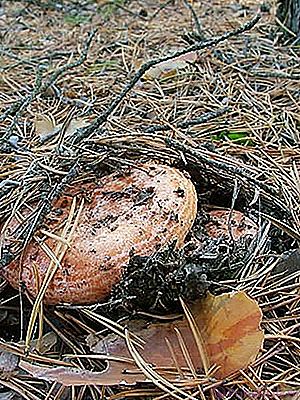
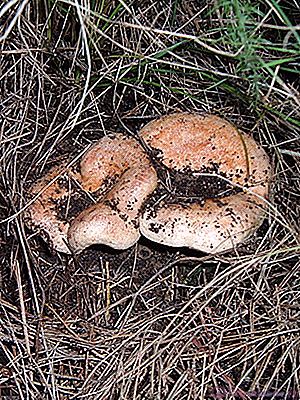
Where to find it: in coniferous forests next to spruce and pine trees, often buries itself in moss.
Eating: Not suitable for drying, but excellent mushroom for pickling or pickling. There are many recipes. These are spicy mushrooms, and with bay leaves, and amazing sauces. Connoisseurs-culinary experts say that real mushrooms cannot be washed, it is enough just to wipe them to clean them of forest debris and dust.
Application in folk medicine: not used, but representatives of traditional medicine were able to isolate the antibiotic lactariovilin from this mushroom, which destroys the tubercle bacillus.
Other names: pine mushroom, common mushroom, gourmet mushroom, pine mushroom, noble mushroom, autumn mushroom.
Cooking recipes
Elovik has high nutritional qualities and is used both fresh and pickled. These mushrooms are absolutely not suitable for drying.
Primary processing
The mushroom has a characteristic milky juice in the pulp, which gives a slight bitterness when cooking and in preservation. Some cooks soak the spices to get rid of the milky juice, but most do not, since the characteristic gives a special taste to the finished dish.
Cooking
Do not boil mushrooms before frying - they can darken from contact with water. Cooking is only used before marinating as part of the process:
- Washed mushrooms are boiled in water according to the recipe, the liquid is drained immediately after the end of cooking.
- Boiled mushrooms are thrown into a colander and allowed to drain completely.
Pickling
Ingredients:
- water (preferably spring water);
- vegetable oil - 5 tablespoons;
- peeled fir trees - 1 kg;
- greens;
- salt - 4-5 tbsp. l .;
- vinegar - 1 des.l.;
- small head of garlic;
- Bay leaf;
- allspice or black peppercorns;
- spices to taste.
How to cook spruce mushroom:
- Mushrooms are boiled for 30-40 minutes.
- Prepare a brine: add garlic, spices, salt, vegetable oil and vinegar to a small amount of water.
- The marinade is boiled for 10 minutes.
- Spruces are laid in layers in sterile jars.
- Mushrooms are poured with hot brine.
- The jar is closed with a nylon lid or rolled up with a metal one.
Cold salting for the winter
Ingredients: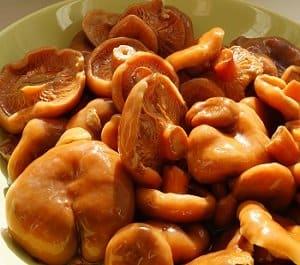
- peeled mushrooms - 5 kg;
- rock salt - 10 tbsp. l .;
- bay leaf - 4 pcs.;
- black peppercorns - 3 tbsp. l .;
- cherry leaf - 20 pcs.;
- horseradish leaf - 4 pcs.;
- fresh dill umbrellas - 4-5 pcs.
Preparation:
- Cherry and horseradish leaves are poured over with boiling water and divided into two parts.
- The first part of the greens is placed on the bottom of the pan.
- The washed mushrooms are placed in layers in a saucepan, sprinkling each layer with salt and putting dill umbrellas, bay leaves and peppers.
- The second part of the leaves is folded on top.
- Cover the pan with a smaller lid and put it under a press.
- Marinated for 3-4 weeks in a cool, dark place.
- For storage, ready-made mushrooms are transferred to sterile jars and rolled up with metal lids.
Canning
Ingredients:
- spruce trees - 1 kg;
- spring water;
- salt to taste.
Preparation:
- Boil the mushrooms for 1-2 minutes.
- Boiled mushrooms are immediately cooled in cold water and discarded in a colander.
- After the water is completely drained, the mushrooms are placed in containers.
- Pour cold water with 1 tbsp. salt so that it does not completely cover the mushrooms.
- The container is covered with gauze and placed under a press.
- Leave the mushrooms under pressure for 30-40 days.
- After salting, the mushrooms are laid out in sterile jars and rolled up or closed with nylon lids.
Where and at what time does it grow
Fans of salted forest mushrooms are interested in where the mushrooms grow. They are ubiquitous, although they are most common in Europe and North America. Most of the species live in symbiosis with conifers, so you need to look for them under spruces, pines and Crimean firs. The only exception is oak mushroom, which is also called milk mushroom. It grows under deciduous trees.
Lighting is of great importance for the growth of fruit bodies. Ryzhiks do not tolerate shade and too dense forests, therefore they are more often found on forest edges, glades and glades. On sandy loam soil, they are often found in large groups, forming "witch circles".
The pulp of saffron milk caps is very tender and does not tolerate cold. Therefore, the harvest season falls in the summer months and autumn. The optimum temperature for the development of fruiting bodies is + 17-27 degrees. With the onset of frost, the reproduction of mushrooms stops.

